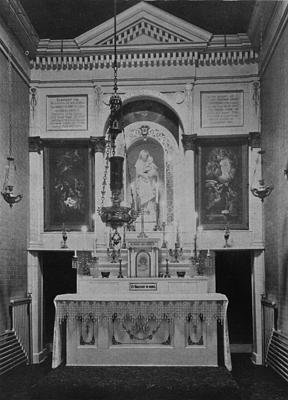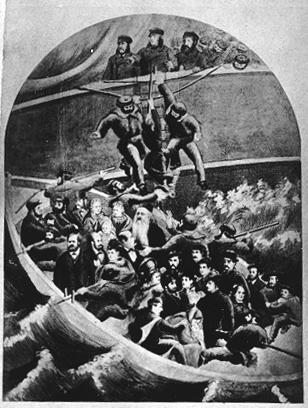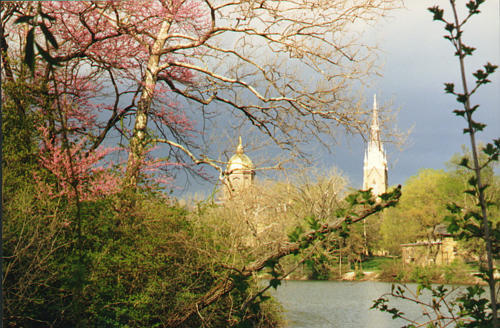
Notre Dame's Grotto / by Dorothy V. Corson


Chapel of Loretto Receives Solid Silver Star
In that same year, 1875, another item of special interest linked to this Blessed Virgin statue concerning Father Sorin appeared in the Ave Maria:

In the Chapel of Loretto, at St. Mary's Convent, Notre Dame, Indiana, is suspended a star of pure silver, with the following inscription: "Ave Maris Stella; Dec. 24th, 1875," just above the head of the statue of the Blessed Virgin. Crowning her brow with its quiet radiance, it proclaims its touching history while arousing new confidence in the protection of the "Gentle Star of the Ocean." This beautiful and appropriate votive offering was made by Miss Eliza Allen Starr, in thanksgiving for her preservation through the dangers of her voyage to Europe. The date it bears is that of the landing in Havre of the steamship L'Amerique, after the memorable and disastrous breaking of her shaft in mid-ocean on the 21 of November, 1875. The perils of a disabled ship on the high seas, the tempests, the suspense, the starvation, the pestilence triumphed over, together with the prompt and miraculous discovery made by the gallant ship of rescue, the welcomed Ville de Brest, were providences most gratefully accorded to the intervention and loving patronage of "Mary, Star of the Sea," to whom the voyage was confided.(49)
The Blessed Virgin is called the Star of the Sea, says St. Thomas, because as sailors are guided to their port by the polar star so Christians are guided in the voyage to eternal glory by Mary.
Sorin also Rescued from Disabled Ship
Father Sorin was on the same ship. Their miraculous rescue was depicted in a painting that once hung in the Sacred Heart Church. A letter written by him aboard the steamer that rescued them, Ville de Brest, was published in the Scholastic : The Ville de Brest was sent by the French Transatlantic Steamship Co. to cruise for the Amerique. They started looking for her on November 24, 1875, and sighted her on December 5th, but because of rough seas were not able to get close enough to effect a rescue until a week later, on December 12. She was towed into Queenstown harbor and thence to Harve and arrived December 17, 1875. Excerpts from Sorin's description of the rescue follow:

The officers of this vessel deserve the highest praise for their noble and persevering efforts to save us. They suffered extremely in keeping themselves at a proper distance during the gale which lasted a whole week after our first meeting. . . . I saw the "Ville de Brest" crossing us starboard, scarcely twenty feet from our bow, whence a single sea would have dashed her against us. . . . Five minutes later both steamers were tossing and rolling at a distance of half a mile from each other, which position remained the same for a full four days, the storm in the meantime continued with unabated violence [after the rescue]. The events which transpired on board will not be soon forgotten. Miss Starr had never before passed through such an ordeal. She went down bravely enough half the length of the rope ladder along the side of the big boat, but when she reached the lower boat I could see she was still alive by the sign of the cross she was making and repeating. Ah! She is a Christian woman.(50)
Eliza Starr was closely connected with both Notre Dame and St. Mary's. When her artist's studio in Chicago was destroyed during the Chicago fire, in 1871, she was invited to reside at St. Mary's as the head of their art department. She returned to Chicago in 1878, but still commuted to St. Mary's to teach. Many of her stories and poems are in the early Scholastic and Ave Maria magazines in the stacks at the Hesburgh Library. In 1885, she became the first woman to receive the Notre Dame Laetare medal for her many artistic contributions.
Although the solid silver star no longer adorns the statue in the Chapel of Loretto, several items belonging to Eliza Starr are displayed in the Heritage Room, the convent museum in Bertrand Hall. Among them, are her rosary, and a beautiful egg-sized cameo of the Blessed Virgin, which was blessed and given to her by the Pope.
In 1881, Eliza Starr wrote a lovely poem about the University:
| Notre Dame as Seen from the Saint Joseph River The purple air, the misty hills;
|

If Sorin had been lost at sea, would it have altered Notre Dame's destiny?